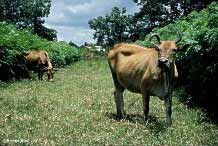|
Fodder

The foliage or fruit of a number of different tree species
can be used as a source of stock fodder, particularly during
feed shortages. The potential for trees to provide valuable
stock feed depends largely upon the type of stock and the
relative costs of alternative fodder options. Sheep and cattle,
although similar in their nutritional requirements, have quite
different grazing habits and may require different tree species
or management systems. Because the cost of establishing and
managing tree fodder systems is commonly much higher than
for pastures or annual fodder crops, trees are only likely
to be an option as an alternative or supplement for hay crops
or purchased feed. To be effective, a tree fodder system must
provide fodder of sufficient quality and quantity at a cost
comparable to other alternatives.
Fodder Quality
Assessment of the quality of forage is usually based on its
nutrient and energy content, digestibility and the presence
of any toxins or anti-nutritional compounds such as tannins,
oils and salts that may limit consumption. Whilst laboratory
tests of nutritional value and digestibility suggest that
the foliage of many tree species may make reasonable forage,
high tannin and toxic content of leaves must also be taken
into account. For example, the tannin content of the foliage
of Tagasaste, a common fodder shrub, increases as the leaves
mature, making older foliage much less valuable as fodder.
If farmers are able to manage the plant so that they use only
new foliage, then weight gains will be better than where the
trees are browsed only once or twice a year.
Some examples of important tree fodder are the pods or fruits
of many trees such as Honey Locust and Carob which usually
ripen and fall in late summer or autumn. These may provide
a high-energy fodder supplement at a time of year when pastures
are dry and low in sugar and protein.
Access and Availability of Fodder
Tree fodder quality might only be of concern during times
of severe feed shortages, such as periods of extended drought,
where it may be insufficient to maintain live weight and stock
health. Many Australian native species including the highly
regarded Kurrajong that grow naturally (and have been widely
planted by farmers) in dryland grazing areas are commonly
used as emergency drought fodder. Although the costs of lopping
the branches or pushing over the trees may be high, it is
often seen as preferable to selling valuable stock.
The costs of making tree fodder available to stock will be
less where trees can be directly grazed. Because overgrazing
and ringbarking can easily kill a tree and the time required
for regrowth after grazing is usually much longer than for
pastures, fodder trees that are to be directly grazed are
most commonly established in blocks. This allows stock access
to be controlled, ensuring that stock do not overgraze the
trees. Where the foliage must be cut the costs of management
increase dramatically.
Site Suitability
One of the greatest advantages of fodder trees is that they
can be grown on sites unsuitable for pasture or fodder crops.
On the deep sands of Western Australia, Tagasaste is able
to out-perform pastures, control recharge and protect soil
from wind erosion. A range of saltbushes have been grown on
saline discharge areas where little else will grow. In addition
to reducing surface evaporation leading to high surface soil
salinity, saltbush provides supplementary fodder for stock.
In high rainfall regions, willows might be grown as a summer
feed source where pastures suffer winter waterlogging.
Fodder Trees Can be Aggressive Weeds
Many introduced fodder tree species have become aggressive
weeds. Tagasaste isa common bushland weed on sandy sites across
southern Australia and Honey Locust is now a declared weed
in Queensland. Willows that are able to set seed are choking
rivers in many states and are commonly listed as declared
weeds. Farmers must be cautious about introducing any exotic
tree species into their farming systems without advice. The
costs of control can be very much higher than the benefits
derived if the plants turn out to be weeds.
Back to top
|
